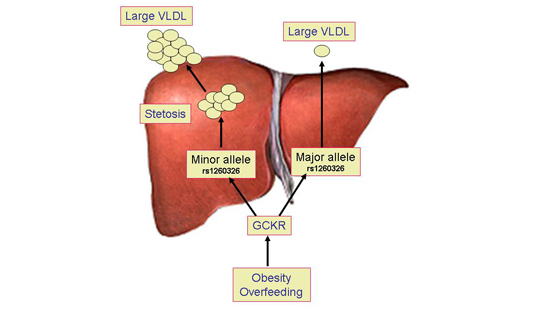Obese Children with Genetic Variants Susceptible to Fatty Liver Disease
March 27, 2012

Fatty liver in obesity.
Obese youths with particular genetic variants may be more prone to fatty liver disease, a leading cause of chronic liver disease in children and adolescents in industrialized countries, according to new findings by Yale School of Medicine researchers.
The study, which focused on three ethnic groups, is published in the March issue of the journal Hepatology.
Led by Dr. Nicola Santoro, associate research scientist in the Department of Pediatrics at Yale School of Medicine, the authors measured the hepatic, or liver, fat content of children using magnetic resonance imaging. The study included 181 Caucasian, 139 African-American and 135 Hispanic children who were, on average, age 13.
“We observed that a common genetic variant known as Patatin-like phospholipase domain containing protein-3 (PNPLA3) working with a regulatory protein called glucokinase (GCKR), was associated with increased triglycerides, very low-density lipoproteins levels, and fatty liver,” said Santoro.
Santoro explained that his observations could help unravel the genetic mechanisms that contribute to liver fat metabolism. “This may drive the decisions about future drug targets to treat hypertriglyceridemia and non-alcoholic fatty liver disease,” he said.
Childhood obesity is a global health concern. Experts say nonalcoholic fatty liver disease is now the leading cause of chronic liver disease in children and adolescents in industrialized countries.
“Our findings confirm that obese youths with genetic variants in the GCKR and PNPLA3 genes may be more susceptible to fatty liver disease,” said Santoro, who is cautious about automatically extending this observation to the overall population.
“Our data refer to a population of obese children and adolescents,” he said. “I think that further studies in a larger sample size involving lean subjects and adults may help to further define in more details these associations.”
Other authors on the study included Clarence K. Zhang, Hongyu Zhao, Andrew J. Pakstis, Grace Kim, Romy Kursawe, Daniel J. Dykas, Allen E. Bale, Cosimo Giannini, Bridget Pierpont, Melissa M. Shaw, Leif Groop, and Sonia Caprio.
The work was also funded, in part, by the Yale Clinical and Translational Science Award grant from the National Center for Research Resources at the National Institutes of Health.
Source: Karen N. Peart, Yale News
Image: Yale News
No comments:
Post a Comment